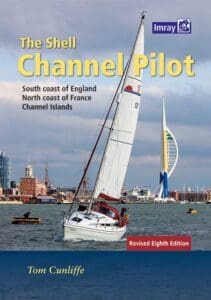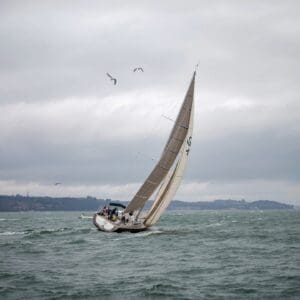The Call to Sail After Sunset
Last weekend was a milestone for me. It might sound odd to some, but I’ve been sailing for nearly three years and never plucked up the courage to say “yes” to a night passage. Much as I love being out on the water, for some reason, the idea of leaving harbour in fading light, navigating out onto the Solent in the dark, and dropping anchor after midnight was both exciting and unnerving. But finally, when a friend offered me a berth for a late-summer hop from Hamble to Newtown Creek he was planning as part of his coastal skipper prep, I knew this was my chance. A boat full of experienced sailors meant I was really just going to be a passenger along as ballast anyway.
Planning the Passage
What I learned was that, just like any other passage, night sailing is all about preparation. We gathered in the saloon an hour before departure with paper charts spread across the table and steaming mugs of tea in hand.
- Route: Out of the Hamble – run down past Cowes – into Newtown Creek.
- Tide: Depart at HW Portsmouth -2 hrs to carry the ebb west.
- Hazards: Ferry traffic at Southampton Water, yachts and ribs coming out of Cowes, and the shallow bar at Newtown’s entrance.
- Lights & Marks: Bramble Bank buoy (Fl.R.2.5s), Gurnard North Cardinal (VQ), and the unlit shoreline of the Isle of Wight.
There was also a timely reminder that at night, navigation relies less on scenery and more on light patterns, compass bearings, and instruments.
Gear and Boat Checks
The weather didn’t feel particularly cool but, on the skipper’s advice, I added a warm mid-layer, woolly hat, and skipped a pair of gloves into my pocket – and it turned out to be sound advice because, as I found out, even in August the night air can bite once the sun drops. Finally, before slipping lines, we checked the jackstays along the deck and clipped on our tethers – skippers rule: clip on when you want, when I tell you, and always at night! Lifejackets also stayed on for the entire trip. We also tested navigation lights, switched the cockpit to red LED mode, and stowed anything that could roll or rattle. On the way out of Hamble I learned quickly that loose mugs are twice as annoying in the dark.
The First Hours Underway
Motoring down the Hamble, the sunset painted the sky in pinks and golds. By the time we passed Calshot, the first stars appeared and the familiar shoreline began to dissolve into shadow. My first helm at night was a lesson in trust – trust in the compass, trust your charts (the skipper swore by Imray Charts for inshore passages) the faint loom of buoys ahead, and the skipper’s quiet instructions. Depth sounder, AIS targets, and the glow of the chartplotter became my new horizon.
The Magic and the Challenges
By Cowes, the breeze filled in and we cut the engine. The world shrank to the pool of red light in the cockpit and the dark water hissing past the hull. We tracked the crossing ferries, lit up like floating towns, and an amazing numbers of ribs that were, apparently, off for a night out in Portsmouth – who knew!. What struck me most was the calm – not just in the sea state, but in the crew. Conversations softened and we moved more deliberately. Every action was explained before it happened. I realised how vital clear communication is when visibility is reduced. The challenge? Depth perception. Lights can appear closer than they are, and it’s easy to mistake a yacht’s masthead tricolour for a distant navigation mark. I learned to confirm every light by its colour, rhythm, and charted position.
Arrival Under the Stars
Approaching Newtown Creek, we slowed, dropped the main, and motored in. The entrance was a black gap in the shoreline, with the faint outline of the shingle spit to starboard. Depth readings and the skipper’s memory were our guide. We were lucky and, rather than having to anchor, we were able to pick up one of the mooring buoys provided by the national Trust. The boat swung gently as we shut everything down. Standing on deck, I saw more stars than I’d ever noticed from land. The quiet was broken only by water lapping the hull.
Lessons for a First Night Passage
FSo what were my takaways? For anyone thinking about their first night sail, here’s what I wrote in my logbook:
Night Passage:
- Know where you are going and how you plan to get there – Plot the route and mark key lights on the paper chart before touching the plotter.
- Double-Check Gear – Warm clothing, headtorch with red mode, and spare batteries are musts.
- Rig Safety Early – Jackstays and tethers before departure. Check the yacht’s navigation lights.
- Keep Communication Simple – Short, clear instructions prevent mistakes.
- Trust but Verify Lights – Cross-check each light’s flash pattern and bearing; beware of distance perception
- Manage Fatigue – Even short night passages can be tiring on the eyes – rotate helms and lookouts.
Why It Was Worth It
As I discovered, night sailing strips away distractions. Without landmarks, you become more attuned to the boat’s motion, the feel of the wind, and the rhythm of the sea. That first night passage turned my nervous anticipation into a quiet confidence – and a hunger to do it again.
Now, if someone asks if I’ll sail after dark, the answer is simple: “When do we leave?”


